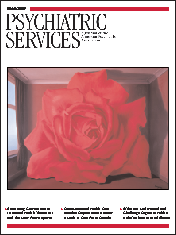Availability of Behavioral Health Treatment for Women in Prison
Abstract
OBJECTIVES: This study examined whether women with behavioral health needs are more likely to receive treatment for these problems in prison or in the community and to what extent prison disrupts or establishes involvement in treatment for these women. METHODS: Data were collected in August 2004 as part of a population survey of female inmates in the only state correctional facility for women in New Jersey. RESULTS: A total of 908 women were surveyed. Fifty-six percent of the women surveyed reported needing behavioral health treatment before incarceration, but only 62 percent of this group reported receiving such treatment in the community. The rate at which treatment matched need within this population before incarceration varied by type of treatment needed: it was the highest (58 percent) for women who needed treatment for mental health problems, lower (52 percent) for those who needed substance abuse treatment, and lowest (44 percent) for those who needed treatment for comorbid mental health and substance abuse problems. In comparison, the rate of match between need for and receipt of treatment in prison was higher for all three types of behavioral health treatment (78 percent, 57 percent, and 65 percent, respectively). Additionally, the findings suggest that prison did not disrupt the type of behavioral health treatment that inmates had previously received in the community. CONCLUSIONS: At least in New Jersey, prison appears to improve access to behavioral health treatment among female inmates. Although this conclusion is consistent with the rehabilitation goals of incarceration, it also suggests that some women may have been able to avoid prison if treatment had been provided in the community, especially for substance-related problems.



